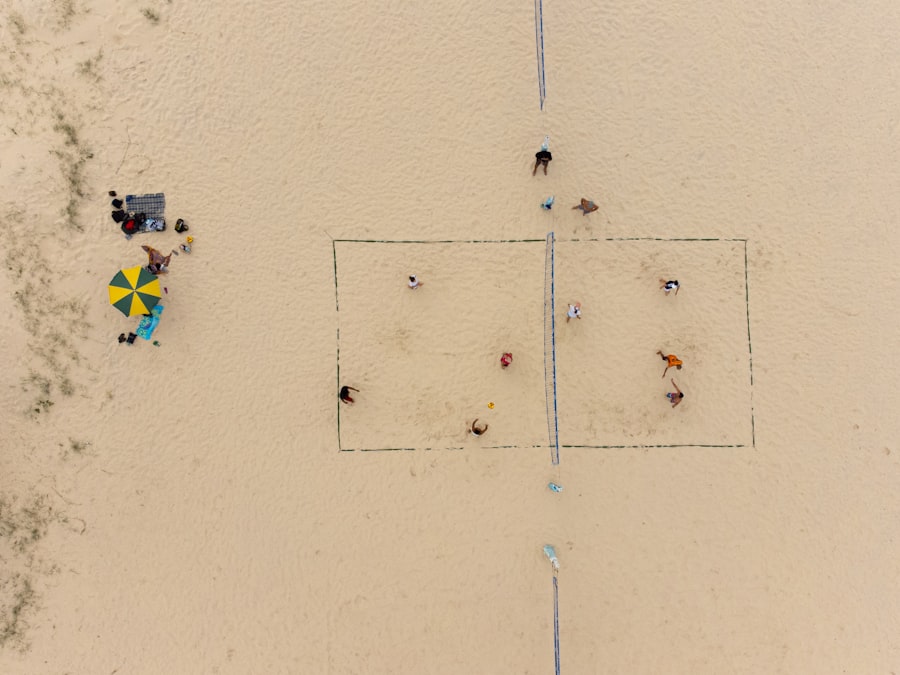Mastering the Art of Volleyball: Tips for Success
Description
Volleyball is a dynamic and fast-paced sport that has captivated millions around the globe. Originating in the United States in 1895, it has evolved into a highly competitive game played both indoors and on the beach. The fundamental objective of volleyball is simple: two teams, typically consisting of six players each, aim to score points by sending a ball over a net and into the opposing team’s court.
The game is played in sets, with teams needing to reach a predetermined number of points, usually 25, to win a set, and the first team to win three sets is declared the victor. The court dimensions are crucial to understanding the game. A standard indoor volleyball court measures 18 meters long and 9 meters wide, divided by a net that stands at a height of 2.43 meters for men and 2.24 meters for women.
Each side of the court is further divided into front and back rows, which play a significant role in positioning players for offensive and defensive plays. The rotation system is another essential aspect; players must rotate positions after winning the serve from the opposing team, ensuring that all players participate in both offensive and defensive roles throughout the match.
Key Takeaways
- Volleyball is a team sport played with a ball and a net, with the objective of sending the ball over the net and into the opponent’s court.
- Essential skills for success in volleyball include passing, setting, serving, spiking, and blocking.
- Mastering the art of serving involves developing a consistent and powerful serve, as well as strategic placement to disrupt the opponent’s defense.
- Improving setting techniques requires precise hand placement, footwork, and communication with teammates to set up successful attacks.
- Perfecting spiking and hitting involves timing, power, and accuracy, as well as the ability to read the opponent’s defense and adjust accordingly.
Developing Essential Skills for Success
To excel in volleyball, players must cultivate a diverse set of skills that encompass both individual abilities and team dynamics. Fundamental skills include passing, setting, hitting, serving, and blocking. Each skill requires dedicated practice and an understanding of proper techniques.
For instance, passing, often referred to as “bumping,” involves using the forearms to receive the ball accurately. A well-executed pass can set up a successful play, making it essential for players to develop their hand-eye coordination and timing. Setting is another critical skill that serves as the foundation for offensive plays.
A setter must possess quick reflexes and an acute sense of spatial awareness to deliver accurate sets to hitters. This requires not only technical proficiency but also an understanding of each hitter’s strengths and preferences. Players should engage in drills that focus on footwork and hand positioning to enhance their setting abilities.
Additionally, practicing with teammates can help develop chemistry, allowing setters to anticipate their hitters’ movements and preferences during matches.
Mastering the Art of Serving

Serving is often considered one of the most crucial skills in volleyball, as it initiates each rally and can significantly impact the game’s momentum. There are various types of serves, including underhand, overhand, jump serves, and float serves, each with its unique advantages and challenges. The underhand serve is typically easier for beginners to master, providing a reliable way to get the ball over the net with minimal risk of error.
However, as players progress, they should focus on developing more advanced serving techniques. The overhand serve is a powerful option that can catch opponents off guard if executed correctly. It requires precise timing and body mechanics to generate speed and spin on the ball.
Jump serves add an additional layer of complexity; players must time their jump perfectly to strike the ball at its highest point while maintaining control. Practicing these serves in various game scenarios can help players develop confidence and adaptability on the court. Additionally, understanding the opponent’s weaknesses can guide strategic serving choices, allowing players to target specific areas of the court for maximum effectiveness.
Improving Your Setting Techniques
| Setting Techniques | Success Rate | Improvement |
|---|---|---|
| Hand Positioning | 80% | Focus on consistent hand placement |
| Footwork | 75% | Work on quick and precise movements |
| Timing | 85% | Practice anticipating the ball’s trajectory |
| Communication | 90% | Improve verbal and non-verbal cues with teammates |
Setting is often regarded as one of the most intricate skills in volleyball due to its pivotal role in orchestrating offensive plays. A setter’s primary responsibility is to deliver accurate sets that enable hitters to execute successful attacks. To improve setting techniques, players should focus on several key elements: footwork, hand positioning, and timing.
Proper footwork allows setters to position themselves optimally for each set, ensuring they can deliver the ball with precision.
Practicing different types of sets—such as high sets for outside hitters or quick sets for middle blockers—can enhance a setter’s versatility.
Additionally, communication with teammates is vital; setters should develop a rapport with their hitters to understand their preferences and tendencies during matches.
Perfecting Your Spiking and Hitting
Spiking is one of the most exhilarating aspects of volleyball, showcasing a player’s athleticism and power. To become an effective hitter, players must master several techniques that contribute to successful spikes. The approach is critical; it typically involves a three- or four-step run-up that builds momentum before jumping to hit the ball.
Timing is essential; players must jump at the right moment to connect with the ball at its peak height. Once airborne, hitters should focus on their arm swing mechanics. A strong arm swing generates power and allows for various types of hits, such as cross-court shots or down-the-line spikes.
Practicing different hitting angles can keep opponents guessing and create opportunities for scoring points. Additionally, understanding defensive formations can help hitters identify gaps in the opposing team’s defense, allowing them to target specific areas effectively.
Enhancing Your Defensive Strategies

Defense is a critical component of volleyball that often determines a team’s success during matches. Players must develop strategies that allow them to effectively read opponents’ attacks and respond accordingly. One fundamental defensive skill is digging, which involves using forearms or hands to receive powerful spikes from opponents.
To improve digging techniques, players should practice positioning themselves correctly based on the hitter’s approach and angle. Blocking is another essential defensive strategy that requires timing and coordination among teammates. A well-timed block can thwart an opponent’s attack and shift momentum in favor of the defending team.
Players should work on their jumping technique and hand positioning to maximize their blocking effectiveness. Additionally, communication among blockers is vital; they must coordinate their movements to cover potential gaps in defense effectively.
Teamwork and Communication on the Court
Volleyball is inherently a team sport that relies heavily on effective communication and collaboration among players. Each member of the team has specific roles and responsibilities that contribute to overall success on the court. Establishing clear lines of communication is essential; players should develop signals or verbal cues that indicate plays or strategies during matches.
Teamwork extends beyond communication; it involves building trust among teammates through practice and shared experiences. Engaging in team-building activities can foster camaraderie and enhance on-court chemistry. Understanding each player’s strengths and weaknesses allows teams to strategize effectively during matches, maximizing their chances of success against opponents.
Mental and Physical Preparation for Peak Performance
Achieving peak performance in volleyball requires not only physical training but also mental preparation. Players must cultivate a strong mindset that enables them to handle pressure situations during matches. Visualization techniques can be beneficial; athletes should practice imagining themselves executing successful plays or overcoming challenges on the court.
Physical conditioning is equally important; players should engage in strength training, agility drills, and endurance exercises to enhance their overall athleticism. Proper nutrition and hydration play crucial roles in maintaining energy levels during matches as well.
In conclusion, mastering volleyball involves understanding its fundamentals while developing essential skills through dedicated practice and teamwork. By focusing on serving techniques, setting accuracy, spiking power, defensive strategies, communication on the court, and mental preparation, players can elevate their performance levels significantly. The journey toward becoming an accomplished volleyball player requires commitment, resilience, and a passion for continuous improvement within this exhilarating sport.
FAQs
What is volleyball?
Volleyball is a team sport in which two teams of six players are separated by a net. The objective is to score points by grounding the ball on the opposing team’s court.
What are the basic rules of volleyball?
The basic rules of volleyball include serving the ball over the net, rallying to keep the ball in play, and trying to score points by grounding the ball on the opposing team’s court. Each team is allowed three touches to return the ball.
What are the different types of volleyball games?
There are several variations of volleyball, including indoor volleyball, beach volleyball, and sitting volleyball. Each variation has its own set of rules and playing environment.
What equipment is needed to play volleyball?
The main equipment needed to play volleyball includes a volleyball, a net, and appropriate footwear. Players may also wear knee pads and other protective gear.
What are the health benefits of playing volleyball?
Playing volleyball can improve cardiovascular health, enhance muscle strength and coordination, and promote overall physical fitness. It also provides opportunities for social interaction and teamwork.
What are the key skills needed to play volleyball?
Key skills needed to play volleyball include serving, passing, setting, attacking, blocking, and digging. Players also need good communication and teamwork skills.





